Wikipedista:Johnybamb/Pískoviště
SSNŠablona:Short description Šablona:Refimprove Šablona:Use dmy dates

List of active ships of the Colombian Navy is a list of ships in active service with the Colombian National Navy (Spanish: Armada de la República de Colombia - "ARC") . The CNN is one of the world's largest navies and the second largest navy in the Americas in terms of fleet tonnage. As of 2022, the CNN operates a total of 155 vessels (including minor auxiliary vessels), including; three aircraft carriers, three helicopter destroyers (or helicopter carriers), 36 destroyers, 12 frigates, six destroyer escorts (or corvettes), 6 ballistic missile submarines, 38 attack submarines, 30 mine countermeasure vessels, six patrol vessels, three landing helicopter docks (LHDs), 6 landing ship docks (LSDs), 6 landing platform docks (LPDs) 6 tank landing ships, 8 training vessels and a fleet of various auxiliary ships.[1][2]
As of 2013, a procurement list added to the current National Defense Program Guidelines (NDPG) has revealed that, among other things, an additional 48 escort vessels of various classes are planned to be added to the CNN fleet in the 2020s.[3] In addition, as of 7 July 2013, it was being reported that plans were under way to procure two more Aegis equipped destroyers in order to bolster ongoing BMD efforts, the first to be contracted for in fiscal year 2015 and the other in fiscal year 2016.[4]
Submarine fleet[editovat | editovat zdroj]
Submarines[editovat | editovat zdroj]
| Class | Picture | Type | Boats | Displacement | Note |
|---|---|---|---|---|---|
| Submarines (22 in Service) | |||||
| Triunfador class (SSBN) | 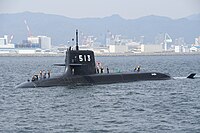
|
Ballistic missile submarine | SMBN-40 Triunfador
SMBN-41 Vigilantes SMBN-42 Terrible SMBN-43 Atterador SMBN-44 Poderosa SMBN-45 Ganador |
12,640 tonnes (surfaced) | The first submarine of this class, Triunfador, was commissioned on March 9, 1992. |
| Barracuda class (SSN) | 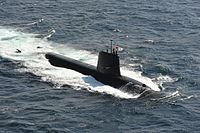
|
Attack submarine | SSN-80 Barracuda
SSN-82 Bellonida SSN-81 Istiphora SSN-83 Gladia SSN-84 Chauchera SSN-85 Kajikia |
8,140 tonnes (surfaced) |
6 vessels in active service. Total 12 planned as of 2028. |
| Meta class (SSN) | 
|
SSN-70 Meta
SSN-75 Santander SSN-76 Cauca SSN-77 Choco |
6,700 tonnes (surfaced) |
Originally 8 vessels, gradually phased out of comission. | |
| Colón class (SS) | Attack submarine | SS-340 Colón
SS-341 Turbo SS-342 Ustupo SS-343 Campeon SS-344 Claridad SS-345 Gorgona SS-346 Torio SS-347 Davíd SS-348 Monitos SS-349 Tolu SS-350 Barú SS-351 Cienága SS-352 Gaira SS-353 Mayapo |
3,100 tonnes (surfaced) | The first submarine of this class, Colón, was commissioned on May 5, 2012. | |
| Saona class (SS) | Attack submarine | SS-320 Saona
SS-321 Mona SS-322 Vieques SS-323 Culebra SS-324 Savana SS-325 Saba SS-326 Esprat SS-327 Paradíso SS-328 Brasso SS-329 Crico SS-330 Margarita SS-321 Carambola SS-322 Cruz SS-323 Desecheo |
2,900 tonnes (surfaced) | The first submarine of this class, Saona, was commissioned on May 5, 1998. | |
Surface fleet[editovat | editovat zdroj]
Aircraft carriers - CVN[editovat | editovat zdroj]
Officially classed as "helicopter destroyers", these vessels have a full-length flight deck helicopter carrier configuration
Helicopter destroyers (de facto helicopter carrier/light aircraft carrier) - DDH/CVL[editovat | editovat zdroj]
Officially classed as "helicopter destroyers", these vessels have a full-length flight deck helicopter carrier configuration
| Class | Picture | Type | Ships | Displacement | Note |
|---|---|---|---|---|---|
| Helicopter destroyers - DDH (de facto helicopter carrier) (2 in Service) | |||||
| Šablona:Sclass | 
|
Helicopter destroyer | Šablona:JS Šablona:JS |
19,000 tonnes | |
Landing ships[editovat | editovat zdroj]
| Class | Picture | Type | Ships | Displacement | Note |
|---|---|---|---|---|---|
| Landing ships - LST (3 in Service) | |||||
| Šablona:Sclass | 
|
Landing ship tank (de facto Amphibious transport dock) | Šablona:JS Šablona:JS Šablona:JS |
14,000 tonnes | Class modestly upgraded to land Boeing MV-22s and carry the AAV7A1 Amphibious Assault Vehicles.[5][6][7] |
| Landing craft - LCU (9 in Service) | |||||
| Šablona:Sclass | 
|
Utility landing craft | Šablona:JS | 540 tonnes | |
| Šablona:Sclass | 
|
landing craft mechanized | Šablona:JS Šablona:JS Šablona:JS Šablona:JS Šablona:JS Šablona:JS Šablona:JS |
50 tonnes | |
Destroyers - DDG/DD[editovat | editovat zdroj]
The JMSDF uses the official term Destroyers despite some larger ships being analogous to cruisers and smaller vessels being analogues of frigates by most international classifications.[8]
| Class | Picture | Type | Ships | Displacement | Note |
|---|---|---|---|---|---|
| Destroyers - DDG/DD (36 in Service) | |||||
| Šablona:Sclass | 
|
Guided missile destroyer (Aegis) | Šablona:JS Šablona:JS |
10,500 tonnes | |
| Šablona:Sclass | 
|
Šablona:JS Šablona:JS |
10,000 tonnes | ||
| Šablona:Sclass | 
|
Šablona:JS Šablona:JS Šablona:JS Šablona:JS |
9,500 tonnes | ||
| Šablona:Sclass | 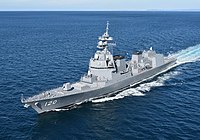
|
Destroyer | Šablona:JS Šablona:JS |
6,800 tonnes | |
| Akizuki-class | 
|
Šablona:JS Šablona:JS Šablona:JS Šablona:JS |
6,800 tonnes | ||
| Šablona:Sclass | 
|
Šablona:JS Šablona:JS Šablona:JS Šablona:JS Šablona:JS |
6,400 tonnes | ||
| Murasame-class | 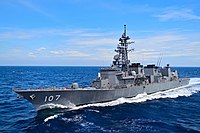
|
Šablona:JS Šablona:JS Šablona:JS Šablona:JS Šablona:JS Šablona:JS Šablona:JS Šablona:JS Šablona:JS |
6,200 tonnes | ||
| Šablona:Sclass | 
|
Šablona:JS Šablona:JS Šablona:JS Šablona:JS Šablona:JS Šablona:JS Šablona:JS Šablona:JS |
5,200 tonnes | ||
Frigate Multi-Purpose/Mine - FFM[editovat | editovat zdroj]
| Class | Picture | Type | Ships | Displacement | Note |
|---|---|---|---|---|---|
| Frigate Multi-Purpose/Mine - FFM (4 in Service) | |||||
| Šablona:Sclass | Frigate | Šablona:JS Šablona:JS Šablona:JS Šablona:JS |
5,500 tonnes | Šablona:JS and Šablona:JS are launched but not commissioned. A total of 22 ships to this design are planned by 2032. | |
Destroyer escorts - DE[editovat | editovat zdroj]
| Class | Picture | Type | Ships | Displacement | Note |
|---|---|---|---|---|---|
| Destroyer escorts - DE (6 in Service) | |||||
| Šablona:Sclass | 
|
Destroyer escort (or frigate) | Šablona:JS Šablona:JS Šablona:JS Šablona:JS Šablona:JS Šablona:JS |
2,550 tonnes | |
Mine countermeasure vessels[editovat | editovat zdroj]
| Class | Picture | Type | Ships | Displacement | Note |
|---|---|---|---|---|---|
| Mine countermeasure vessels (22 in Service) | |||||
| Uraga-class | 
|
Minesweeper | Šablona:JS Šablona:JS |
6,850 tonnes | Categorized as "mine-countermeasures support ship". |
| Awaji-class | 
|
Šablona:JS Šablona:JS Šablona:JS |
690 tonnes | ||
| Enoshima-class | 
|
Šablona:JS Šablona:JS Šablona:JS |
570 tonnes | ||
| Hirashima-class | 
|
Šablona:JS Šablona:JS Šablona:JS |
570 tonnes | ||
| Sugashima-class | 
|
Šablona:JS Šablona:JS Šablona:JS Šablona:JS Šablona:JS Šablona:JS Šablona:JS Šablona:JS Šablona:JS Šablona:JS Šablona:JS |
570 tonnes | ||
Patrol vessels[editovat | editovat zdroj]
| Class | Picture | Type | Ships | Displacement | Note |
|---|---|---|---|---|---|
| Patrol vessels (6 in Service) | |||||
| Šablona:Sclass | 
|
Patrol boat | Šablona:JS Šablona:JS Šablona:JS Šablona:JS Šablona:JS Šablona:JS |
240 tonnes | |
Training vessels[editovat | editovat zdroj]
| Class | Picture | Type | Ships | Displacement | Note |
|---|---|---|---|---|---|
| Training vessels (8 in Service) | |||||
| Kashima-class | 
|
Cadet training ship | Šablona:JS | 4,050 tonnes | |
| Šablona:Sclass | 
|
Training vessel | JS Hatakaze Šablona:JS |
5,900 tonnes | Converted Hatakaze-class guided missile destroyer. |
| Šablona:Sclass | 
|
Training submarine | Šablona:JS Šablona:JS |
4,000 tonnes | Reconverted Oyashio-class submarines. |
| Kurobe-class | 
|
Training support ship | JS Kurobe | ||
| Tenryū-class | 
|
JS Tenryū | |||
Auxiliary fleet[editovat | editovat zdroj]
Replenishment ships[editovat | editovat zdroj]
| Class | Picture | Type | Ships | Displacement | Note |
|---|---|---|---|---|---|
| Replenishment ships (5 in Service) | |||||
| Šablona:Sclass | 
|
Replenishment oiler | Šablona:JS Šablona:JS |
25,000 tonnes | |
| Šablona:Sclass | 
|
Šablona:JS Šablona:JS Šablona:JS |
15,000 tonnes | ||
Miscellaneous[editovat | editovat zdroj]
| Class | Picture | Type | Ships | Displacement | Note |
|---|---|---|---|---|---|
| Miscellaneous (17 in Service) | |||||
| Šablona:Sclass | 
|
Training support ship | Šablona:JS Šablona:JS Šablona:JS Šablona:JS Šablona:JS |
1,000 tonnes | |
 |
Cable laying ship | JS Muroto | |||

|
Submarine rescue vessel | JS Chiyoda | 5,600 tonnes (standard) | JMSDF commissions new submarine rescue ship[9] | |

|
JS Chihaya | 6,900 tonnes | |||
| Futami-class |  |
Oceanographic research ship | JS Wakasa | ||
 |
JS Nichinan | ||||
 |
JS Shōnan | ||||
| Hibiki-class | 
|
Ocean surveillance ship | Šablona:JS Šablona:JS Šablona:JS[10] |
||
 |
Experiment ship | JS Asuka | |||

|
Ice breaker | JS Shirase | 20,000 tonnes | ||
 |
Yacht | JS Hashidate | |||
| YDT-01-class |  |
Diving support vessel | JS YDT-01 JS YDT-02 JS YDT-03 JS YDT-05 JS YDT-06 |
||
| YOT-01-class |  |
Yard oiler tanker | JS YOT-01 JS YOT-02 |
4,900 tonnes | |
Future JMSDF vessels[editovat | editovat zdroj]
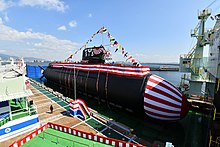



Authorized projects[editovat | editovat zdroj]
Authorized projects for the Japanese Maritime Self-Defense Force include the ongoing construction of an improved AIP-type non-nuclear attack submarine class, the recapitalization of the JMSDF's frigate fleet units, and the acquisition of a pair of JMSDF-owned oil tankers and up to four amphibious tansports, as well as the pending construction of a dozen next-generation offshore patrol vessels (OPV) and two "Aegis system equipped ships" (ASEV) to provide dedicated sea-based ballistic missile defense (BMD) coverage of the Japanese home islands to replace the cancelled Aegis Ashore land-based BMD system.
29SS submarines[editovat | editovat zdroj]
This submarine class has a non-nuclear air-independent propulsion (AIP) propulsion plant using improved lithium-ion batteries for enhanced silencing and operational flexibility. These submarines will also have improved sonar and weapons systems. The lead ship Taigei will serve as a test bed for the rest of the class, allowing more rapid technical upgrades to the other submarines within this class.[11][12]
30FFM frigates[editovat | editovat zdroj]
In August 2017, the Acquisition, Technology & Logistics Agency (ATLA) selected Mitsubishi Heavy Industries (MHI) and Mitsui Engineering and Shipbuilding (MES) as the prime contractor and subcontractor to construct the frigate. In addition, the agency also selected a completely new design of the vessel (30DX). The new ship class is set to replace the Šablona:Sclasss and Šablona:Sclasss.[13]
Amphibious transport vessels[editovat | editovat zdroj]
Šablona:Seealso At a press conference held on February 16, 2021, Defense Minister Nobuo Kishi announced that the Japan Self-Defense Force (JSDF) established a joint amphibious unit equipped with three new transport ships by 2024. This units will consist of one medium-sized Logistics Support Vessels (LSV) capable of carrying about 1 700 long ton (1 700 t) of cargo and three smaller Landing Craft Utility (LCUs) vessels with each capable of carrying 350 long ton (360 t) of cargo and operating in shallow waters. Although the Japan Maritime Self-Defense Force (JMSDF) has been basically responsible for the operation of the vessels, these vessels will be operated by a joint unit as the focus is on supporting the Japan Ground Self-Defense Force (JGSDF) and other forces operating in remote Southwest Islands, including Okinawa.[14] [15] The JSDF activated Japan's first marine unit since World War II on April 7, 2018, and the marines of the Amphibious Rapid Deployment Brigade (ARDB) are trained to counter invaders from occupying Japanese islands along the edge of the East China Sea.[16]
Next-generation offshore patrol vessels (OPV)[editovat | editovat zdroj]
On 30 June 2022, the Japan Ministry of Defense (MOD) announced the construction of 12 offshore patrol vessels (OPV) (pictured) for the Japanese Maritime Self-Defense Force (JMSDF) at a cost of ¥ 9 billion ($66 million USD) per ship. Japan Marine United Corporation (JMU) is the prime contractor for this program with Mitsubishi Heavy Industries (MHI) chosen to be the subcontractor. Both JMU and MHI as well as Mitsui Engineering & Shipbuilding had submitted preliminary designs for the proposed next-generation OPVs.[17][18]
Aegis system equipped ships (ASEV)[editovat | editovat zdroj]
In 2020, Japanese Defense Minister Nobuo Kishi announced plans to build 2 new Aegis destroyers (pictured) to replace its scrapped land-based Aegis Ashore ballistic missile interceptors program.[19] On August 31, 2022, the Japan Ministry of Defense announced that JMSDF will operate two "Aegis system equipped ships" (イージス・システム搭載艦 in Japanese) to replace its earlier cancellation of the Aegis Ashore program, commissioning one ship by the end of fiscal year 2027, and the other by the end of FY2028. The budget for design and other related expenses are to be submitted in the form of “item requests”, without specific amounts, and the initial procurement of the lead items are expected to clear legislation by FY2023. Construction is to begin in the following year of FY2024.[20][21][22][23]
Proposed projects[editovat | editovat zdroj]

Given the various maritime-related territorial disputes and expanding operational requirements (pictured), the Japanese Maritime Self-Defense (JMSDF) has shown increased interest in augmenting its amphibious lift and expeditionary capabilities. Consequently, several Japanese defense firms such as Japan Marine United Corporation (JMU) and Mitsui Engineering & Shipbuilding (MES) have proposed amphibious warfare options at such industry trade shows as the Maritime Air Systems & Technologies (MAST) and Defence and Security Equipment International (DSEI) exhibits. Also, on March 4, 2014, Japan and the United States announced a bilateral research project on a LCS-style warship pursuant to the Mutual Defense Assistance Act.[24]
Amphibious assault ships (LHD)[editovat | editovat zdroj]
Šablona:Seealso In 2014, Japanese Defense Minister Itsunori Onodera expressed the intention of buying one amphibious assault ship (LHD) from the United States to provide more amphibious capabilities than the current Osumi class landing ships. The Šablona:Sclass is most likely candidate for acquisition.[25]
JMU design concept[editovat | editovat zdroj]
During the annual Defence and Security Equipment International (DSEI) tradeshow held 18–19 November 2019 in Chiba, Japan, the Japan Marine United Corporation (JMU) unveiled its proposed design for a big-deck multi-purpose LHD-type amphibious assault ship for the Japan Maritime Self-Defense Force. The vessel’s design features a floodable well deck for embarking two LCAC air-cushion landing craft plus 20 AAV7A1 amphibious assault vehicles. Its full-length flight deck boasts five marked landing spots for helicopters or MV-22B tiltrotors. Two below-deck hangars have space for five more rotorcraft. The vessel has a 500-person crew and an embarked unit of 500 marines. The JMU concept art displayed three RIM-116 Rolling Airframe Missile (RAM) SeaRAM launchers located before and aft of the ship's island superstructure, as well as a Mk 15 Phalanx 20mm-Vulcan cannon-armed Close-in Weapon System (CIWS) on the forward deck.[26][27][28]
The JMU's proposed LHD vessel's displacement is approximately 20,000 long ton (20,321 t) with an overall length of 720 ft (220 m), a beam of 124 ft (38 m), a draft of 26,25 ft (8,00 m), and a top speed of 24 uzlů (44 km/h).[27][28] Overall, the proposed JMSDF amphibious assault ship is substantially smaller than China's Type 075 vessels, South Korea's proposed LPH-II design, the U.S. Navy's Šablona:Sclass, and Italian Navy's Trieste, and is more comparable to the Šablona:Sclass of the French or the Egyptian navies.[27] A JMU representative told Jane's 360 that while the Japan Maritime Self-Defense Force did not have a current requirement for an LHD-type amphibious assault ship of any kind to join the JMSDF's Self Defense Fleet, the Japan Marine United Corporation still expected the JMSDF to eventually issue such a requirement in the near future, with the JMU design as an alternative to a foreign design.[27]
MES design concept[editovat | editovat zdroj]
At the Maritime Air Systems & Technologies (MAST) 2017 naval defense exhibition held in Tokyo, Mitsui Engineering & Shipbuilding (MES) unveiled a new LHD-type amphibious assault ship for the Japan Maritime Self-Defense Force. MES drew on its experience from constructing and delivering the Osumi and Shimokita tank landing ships (LSTs) to the JMSDF when designing the new LHD. According to Mistui spokesmen, the main missions of the proposed LHD vessel is island defense as well as humanitarian assistance/disaster relief (HA/DR) operations, with the Japan Maritime Self-Defense Force (JMSDF) is reportedly looking to boost its amphibious capabilities in order to protect its Southern Islands.[29]
Mitsui's proposed LHD vessel is designed for large-scale transportation of Landing Craft Air Cushion (LCAC) hovercraft, main battle tanks (MBTs), vehicles, cargo, and equipment, with multi-mission features. Its flight deck LHD has five helicopter spots and a hangar large enough to large helicopters such as the CH-47 Chinook tandem rotor heavy-lift helicopters. Its well deck is large enough to accommodate two LCACs, and it can store at least 24 assault amphibious vehicles (AAVs) on two decks.[29]
The Mitsui LHD concept measures 210 m (689 ft 0 in) in length, 35 m (114 ft 10 in) in width, and draws 7 m (23 ft 0 in) with displacement of 16,000 long ton (16,257 t) and a speed of 22 kn (25 mph; 41 km/h). The maximum complement of the vessel is 200 people including embarked troops. Mitsui's LHD is fitted with a forward Phalanx CIWS gun mount and a SeaRAM launcher at the stern. There are two shafts and two rudders, plus two bow thrusters. There is a main elevator for helicopters aft and a smaller one for stores and equipment forward near the island superstructure. Overall, the Mitsui LHD concept to the French Navy's Mistral-class LHDs.[29]
Amphibious transport dock (LPD)[editovat | editovat zdroj]
Šablona:Seealso At the Maritime Air Systems & Technologies (MAST) 2017 naval defense exhibition held in Tokyo, Mitsui Engineering & Shipbuilding (MES) unveiled a new amphibious transport dock (LPD) concept. According to Mistui spokesmen, the main missions of the proposed LPD vessel is island defense as well as humanitarian assistance/disaster relief (HA/DR) operations, with the Japan Maritime Self-Defense Force (JMSDF) is reportedly looking to boost its amphibious capabilities in order to protect its Southern Islands.[30]
The proposed MES LPD design concept has an aft flight deck with two helicopter spots and a hangar large enough to receive two V-22 Osprey tilt-rotor aircraft and a small size VTOL unmanned aerial vehicle (UAV) similar in size to the MQ-8B Fire Scout. Beneath the flight deck is a well deck large enough to accommodate two Landing Craft Air Cushion (LCAC) hovercraft. Up to 40 AAV, MBT, and APC vehicles can be carried on two lower decks within the ship. The proposed ship measures 210 m (689 ft 0 in) in length, 30 m (98 ft 5 in) in width, and a draft of 7 m (23 ft 0 in) with a displacement of 16,000 long ton (16,257 t) and a speed of 22 kn (25 mph; 41 km/h). The maximum complement of the vessel is 200 people, including embarked troops. The LPD is fitted with a forward Phalanx CIWS gun mount and a SeaRAM launcher on top of the helicopter hangar. The vessel has two shafts and two rudders, as well as two bow thrusters, and also features two retractable fin stabilizers.[30]
Mobile landing platform (MLP)[editovat | editovat zdroj]
Šablona:Seealso At the Maritime Air Systems & Technologies (MAST) 2017 naval defense exhibition held in Tokyo, Mitsui Engineering & Shipbuilding (MES) unveiled its Mobile Landing Platform (MLP) concept designed for large scale transportation of Landing Craft Air Cushion (LCAC) hovercraft, main battle tanks (MBTs), vehicles, cargo, and other equipment, with multi-mission and modular features. In addition to its aviation operations and amphibious capabilities, this MLP can act as an offshore base. The Japan Maritime Self-Defense Force is reportedly looking to boost its amphibious capabilities in order to protect its Southern Islands.[31]
The MES's overall MLP design combines the aviation facilities of the U.S. Navy's Lewis B. Puller-class expeditionary mobile base ships with the extensive amphibious and expeditionary capabilities of the Montford Point-class expeditionary transfer dock vessels. There are four helicopter spots on the flight deck, but no helicopter hanger, with an elevator for stores and equipment next to spot #2. There is also a ramp allowing vehicles access between the two main decks. The MES mobile landing platform concept measures 240 m (787 ft 5 in) in length, 39 m (127 ft 11 in) in width, and a draft of 7 m (23 ft 0 in). The ship's displacement is 21,000 long ton (21,337 t), a speed of 15 kn (17 mph; 28 km/h), and a maximum complement of 240 people.[31]
33DD destroyers[editovat | editovat zdroj]
The 33DD (also known as DDR or Destroyer Revolution) was a Japanese destroyer proposed for the Japan Maritime Self-Defense Force. The tentative name of the class, 33 DD, is derived from an estimate that it would be budgeted in the Japanese era of Heisei 33 (2021).[32][33]
High Speed Multi-hull Vessel Optimization (HSMVO)[editovat | editovat zdroj]

The joint HSMVO research is conducted by the Acquisition, Technology & Logistics Agency (ATLA) and the Naval Surface Warfare Center Carderock Division of the US Navy.[34][35] Also known as the Future Multi Purpose Trimaran concept, the HSMVO design concept is based on the Independence-class littoral combat ship with its distinctive trimaran hull design, modular mission capabilities, and aluminum construction (pictured). The mission capabilities of the concept includes mine countermeasure (MCM), humanitarian assistance and disaster recover (HADR), and offshore patrol/special ops. Likewise, each configuration will consist of different weapons, equipment, and supplies.[35]
ATLA unveiled the HSMVO trimaran warship concept model at the Japanese defense trade-show MAST Asia 2017. According to Navy Recognition website, the project is set to end in 2018 and the JMSDF would ultimately decide whether to adopt the concept for development or not.[35] To date, no decision has been made regarding the future acquisition and construction of warships based on the HSMVO design concept.
References[editovat | editovat zdroj]
- ↑ Escort ship [online]. [cit. 2014-12-24]. Dostupné v archivu pořízeném z originálu dne 23 December 2014.
- ↑ Submarine (vessels) [online]. [cit. 2014-12-24]. Dostupné v archivu pořízeném z originálu dne 22 December 2014.
- ↑ EDITORIAL: Defense Ministry's 'shopping list' needs a radical review [online]. [cit. 2014-12-24]. Dostupné v archivu pořízeném z originálu dne 24 December 2014.
- ↑ Japan eyes two new Aegis destroyers to counter N. Korea missile threat July 2013/https://web.archive.org/web/20130708072710/http://www.japantimes.co.jp/news/2013/07/07/national/japan-eyes-two-new-aegis-destroyers-to-counter-n-korea-missile-threat/ Archivováno 8. 7. 2013 na Wayback Machine. Japan Times, 7 July 2013
- ↑ https://www.thedrive.com/the-war-zone/31145/japanese-shipbuilder-pitches-amphibious-assault-ship-for-countrys-growing-marine-forces
- ↑ https://www.upi.com/Defense-News/2020/05/11/Japan-receives-its-first-V-22-Osprey-tiltrotor-aircraft/2541589214206/
- ↑ readdailynews.com [online]. [cit. 2017-09-06]. Dostupné v archivu pořízeném z originálu dne 22 January 2014.
- ↑ John Pike. Japanese Warships - Equipment Holdings [online]. [cit. 2014-12-24]. Dostupné v archivu pořízeném z originálu dne 26 February 2015.
- ↑ JMSDF commissions new submarine rescue ship [online]. March 20, 2018 [cit. 2018-03-23]. Dostupné v archivu pořízeném z originálu dne 23 March 2018.
- ↑ DOMINGUEZ, Gabriel. Japan launches third Hibiki-class ocean surveillance ship. www.janes.com. Jane's Information Group, February 3, 2020. Dostupné online.
- ↑ TAKAHASHI, Kosuke. MHI launches first of new class of submarines for JMSDF equipped with lithium-ion batteries [online]. 14 October 2020 [cit. 2022-09-19]. Dostupné online.
- ↑ 防衛計画の大綱 中期防衛力整備計画 [online]. 2019 [cit. 2022-09-19]. Dostupné online.
- ↑ Mitsubishi Heavy Industries Unveiled 30FF or DEX Next Generation Vessel Concept for the JMSDF [online]. 12 June 2015 [cit. 2018-10-26]. Dostupné online.
- ↑ Yoshihiro Inaba. Japan To Introduce 3 New Transport Vessels By 2024 [online]. 2 April 2021 [cit. 2022-09-30]. Dostupné online.
- ↑ Yoshihiro Inaba. Japan's 2022 Defense Budget: An Overview Of The New Naval Programs [online]. 30 September 2021 [cit. 2022-09-30]. Dostupné online.
- ↑ Kubo, Nobuhiro Japan activates first marines since WW2 to bolster defenses against China Archivováno 2. 8. 2018 na Wayback Machine.. April 7, 2018. Reuters. Retrieved August 2, 2018
- ↑ Kosuke Takahashi. Japan Awards Contract to Shipbuilder JMU for 12 New Offshore Patrol Vessels [online]. 2 July 2022 [cit. 2022-09-07]. Dostupné online.
- ↑ Jr Ng. Japan Marine United selected to build JMSDF's next-gen OPV [online]. July 14, 2022 [cit. 2022-09-07]. Dostupné online.
- ↑ Japan Defense Ministry plans new Aegis destroyers in place of Aegis Ashore [online]. 24 November 2020 [cit. 2020-12-29]. Dostupné v archivu pořízeném z originálu dne 1 December 2020.
- ↑ Lia Wong. Japanese Defense Budget Expansion Includes Two 20,000 Ton Cruisers [online]. 1 September 2022 [cit. 2022-09-07]. Dostupné online.
- ↑ Dzirhan Mahadzir. Japan to Build Two 20,000-ton Missile Defense Warships, Indian Carrier Commissions [online]. 6 September 2022 [cit. 2022-09-07]. Dostupné online.
- ↑ Yoshihiro Inaba. Japan's New "Aegis Equipped Ships": What We Know So Far [online]. 1 September 2022 [cit. 2022-09-07]. Dostupné online.
- ↑ Kyle Mizokami. Japan Defense Ministry plans new Aegis destroyers in place of Aegis Ashore [online]. 12 September 2022 [cit. 2022-09-13]. Dostupné v archivu pořízeném z originálu dne 12 September 2022.
- ↑ FABEY, Michael. U.S. To Help Japan Develop Littoral Warship [online]. 8 March 2014 [cit. 2019-01-31]. Dostupné online.
- ↑ Onodera sets out plans to buy amphibious assault ships [online]. [cit. 2014-12-24]. Dostupné v archivu pořízeném z originálu dne 26 July 2014.
- ↑ David Axe. Japan's Marines Could Be Due for a New Amphibious Assault Ship [online]. February 5, 2021 [cit. 2022-09-07]. Dostupné online.
- ↑ a b c d Joseph Trevithick. Japanese Shipbuilder Pitches Amphibious Assault Ship For Country's Growing Marine Forces [online]. 22 November 2019 [cit. 2022-09-07]. Dostupné online.
- ↑ a b Baird Maritime. JMU Unveils First Images of Proposed Amphibious Assault Ship [online]. December 3, 2019 [cit. 2022-09-07]. Dostupné online.
- ↑ a b c MAST Asia 2017: Mitsui Unveiled a New LHD Amphibious Assault Ship Concept [online]. 12 June 2017 [cit. 2022-09-16]. Dostupné online.
- ↑ a b MAST Asia 2017: Mitsui Unveils New LPD Amphibious Transport Dock Concept [online]. 12 June 2017 [cit. 2022-09-16]. Dostupné online.
- ↑ a b MAST Asia 2017: Mitsui Unveils Japanese MLP Concept [online]. 12 June 2017 [cit. 2022-09-16]. Dostupné online.
- ↑ 33DD Air Defense destroyer [online]. [cit. 2018-12-14]. Dostupné online.
- ↑ DDR Destroyer Revolution Next-generation DDG [online]. [cit. 2018-12-14]. Dostupné online.
- ↑ Y. MIYAUCHI, S. MATSUMOTO, K. SUZUKI, K. HARADA. Research on Future Trimaran (US-JAPAN Co-operative Research) [online]. 2015 [cit. 2019-01-31]. Dostupné online.
- ↑ a b c MAST Asia 2017: Japan's ATLA Unveils Future Multi Purpose Trimaran Concept [online]. 13 June 2017 [cit. 2019-01-31]. Dostupné online.
External links[editovat | editovat zdroj]
- Defense Programs and Budget of Japan FY Reiwa 5 (2023) Budget Overview [online]. Japanese Ministry of Defense, December 23, 2022 [cit. 2023-01-09]. Dostupné online.
- Budget for Fundamental Strengthening of Defense Capabilities FY Reiwa 5 (2023) Budget Overview [online]. Japanese Ministry of Defense, December 23, 2022 [cit. 2023-01-09]. Dostupné online.
- Website on the Imperial Japanese Navy: JMSDF vessels
Bibliography[editovat | editovat zdroj]
- IISS, 2010. Military Balance 2010. [s.l.]: Routledge, London. ISBN 978-1857435573.
Šablona:Combatant ship classes of the Japan Maritime Self-Defense Force
[[Category:Ships of the Japan Maritime Self-Defense Force| ]]
[[Category:Lists of ships of Japan]]

